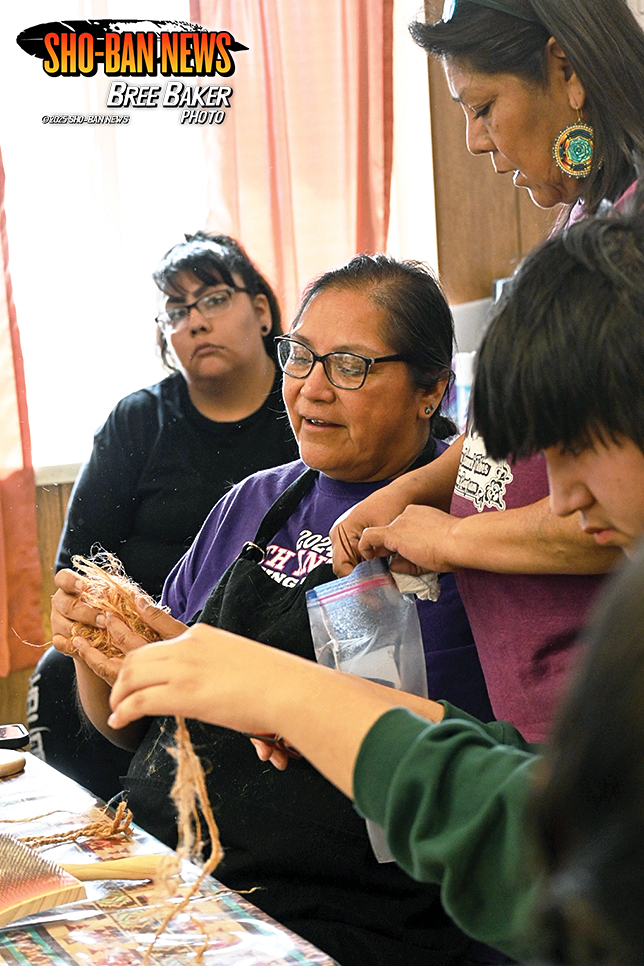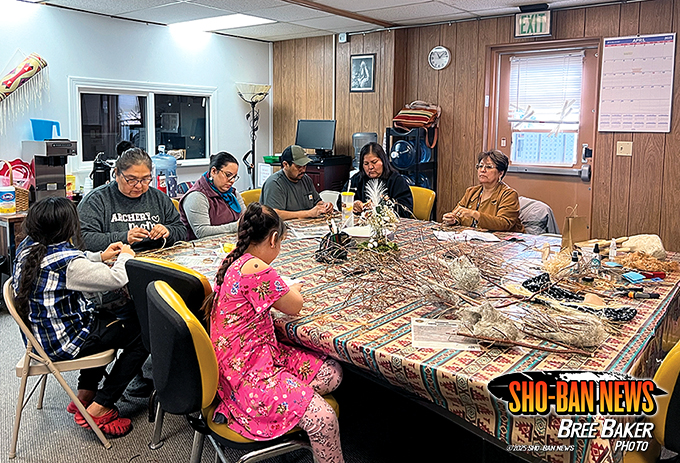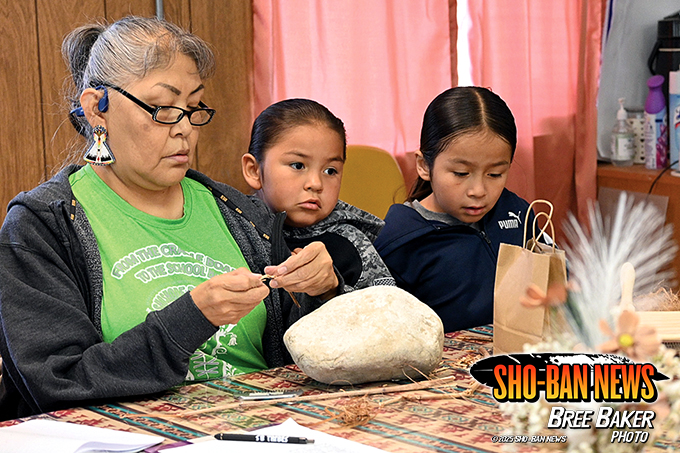Language & Culture Preservation hosts Nets & Ropes Workshop

Instructor Bobette Haskett shows dogbane fibers to workshop participants
on Saturday, April 12.
By BREE BAKER
Sho-Ban News
FORT HALL — The Shoshone-Bannock Language and Culture Preservation Department (LCPD) hosted a Nets and Ropes Workshop on Saturday, April 12, where community members learned how to make nets and ropes using traditional plants.
Bobette Haskett served as the instructor. Nolan Brown opened the workshop with a prayer. Lunch was provided to participants, a meal of potato bacon soup, sandwiches, and a twist, catered by Butterburrs. More than 25 people attended the workshop.
Haskett, who has worked with traditional plants and fibers for several years, shared her knowledge about dogbane also known as Indian hemp and demonstrated how to extract the plant’s fibers to create rope. All materials were provided, and participants worked with dogbane sticks to learn the fiber preparation process. The sticks were broken to be able to remove the fiber, some participants used their feet and others used tools to break the stick apart. Next was the removal of wood pieces, which left participants with the fibrous material which was rolled and twisted into a small rope.
The workshop was held in partnership with s'gʷi gʷi ʔ altxʷ (House of Welcome) at The Evergreen State College in Olympia, Washington. Linley Logan, Program Specialist for the Northwest Heritage Program and a member of the Onödowá’ga’ (Seneca) Nation, was in attendance. Logan has worked with the Northwest Heritage Program for 12 years and has overseen 50 workshops. He travels to tribal communities to support the advancement of Native American tribal arts and cultures. He said the program originally started out with Washington and Oregon as service areas defined by their philanthropic funder. At the start of the seventh year, they asked us to include Idaho and Montana in their service area. The program budgets for six workshops each year, with up to $6,000 allocated per workshop. The focus is primarily on reaching rural tribal communities across Washington, Oregon, Idaho, and Montana. Logan explained that they host a variety of workshops based on what each community wants to learn. “We’re primarily focused on customary traditional arts that need life breathed back into them to keep them strong like dogbane.” He shared examples of past projects, such as willow weaving, dogbane rope-making, plateau dresses, baskets, baby boards, and more. He said “It’s always great to be in the community for things like this. Getting to know the community and interacting with them.” Logan added, “The program pays for the supplies, the lunch, and an honorarium for the instructors.”

Community members of all ages attend the LCPD workshop.
Haskett’s journey into rope making began while working for LCPD. She recalled sitting at her desk one day, reading a book though she can’t remember the exact title. The book mentioned how Native people traditionally used various plants to make cordage. The mention of materials like milkweed, stinging nettle, and dogbane sparked a curiosity to learn more. “I already knew a little about milkweed and nettle,” she said.
Her curiosity led her to start experimenting with native plants on her own. She recalled an early attempt with stinging nettle, “I got little stickers in my hands, and it was really painful. After that, I used gloves and was able to work the fiber out.”
She knew about dogbane but didn’t see it anywhere on our reservation. Dogbane isn’t as common as stinging nettle and milk weed. Farmers and ranchers consider it a weed because it poses a threat to livestock, so they get rid of it. “I think that’s one of the reasons we don’t know much about it, it’s just not around,” said Haskett.
In search of the plant, Bobette and her husband Russell went to look for it, they traveled down Bottoms near the Snake River, where they were able to locate and harvest dogbane. Haskett’s knowledge about dogbane comes from a variety of sources. She recalled watching a video of Native American women from Nevada and learning how they traditionally harvested and processed the plant to extract its strong fibers. She also attended a dogbane symposium in Washington.
“Originally, we harvest dogbane in the fall,” Haskett explained. “In the summer, it’s too poisonous and fresh with latex fluid inside.” Haskett expressed hope the learning will continue beyond this workshop. “I’d like to see this class carry on and go on a field trip in the fall to harvest dogbane and be able to see what it looks like” she said. “Maybe in the future, we can have a longer class, pick more dogbane, and make a good-sized rope.”
Haskett says it is a traditional skill that few people continue to practice today. She credits the LCPD for its efforts to educate the community and help people relearn or remember these teachings. Haskett said “A lot of our elders knew these teaching but that was a generation affected by boarding schools and historical trauma. Some things didn’t get passed down or shared.” She added that many elders are now beginning to recall memories of what their own grandparents used to do so “We need to keep carrying that on,” she said.
“I know everybody wants to learn,” Haskett said. “Today was a good class, it was a good turnout. I just shared my experience with it, and I think they caught on. We had little ropes all over the place. It was fun to watch and see them make it.”

Gwyn Towersap shows Dogbane/Indian Hemp to grandsons Ahtzah and Neiko Broncho.
Haskett spoke about how deeply our traditional knowledge is tied to survival and identity. “Our traditions and cultural ways sustained us and kept us in existence,” she said. “If we didn’t have that knowledge of how to survive, we wouldn’t be here. Our people have been here for millennia, and we’re going to continue to be here. Our traditional knowledge and practices are what will carry us forward. Even though we have modern conveniences they can only carry us so far, it’s important for our young people to learn these teachings. It’s important to get out, breathe the fresh air, walk, hike, and learn about plants. It gives a different perspective about who we are and where we come from.”
Haskett encourages community members to get out and connect with the land around them. “Take a drive, go for a hike, take the kids and grandkids,” she said. “See what’s out there, see what’s on our own reservation, the land that surrounds us. Getting out doesn’t cost much, but you gain so much from it.” She recalled when her husband took her to see the headwaters of the Portneuf River, where the water first emerges from the ground. “Seeing and knowing that gave me a whole different appreciation of what our people experienced so long ago. We can’t take the outdoors, the woods, the forest, the water, and the fish for granted.” For Haskett “It’s been soul-finding. When I get to go out and see places, thinking this is where our old people were coming from. When they talk about old times, talking about hemp, fibers, medicine, food, and animals we had, it brings it all together.”
She thanks the Language and Cultural Preservation Department for the opportunity to share her knowledge. “I thought it was a good turnout,” she said. “I appreciate Nolan, Bailey, and LCPD for their willingness to let me come in and share what I know. I’m grateful to be a part of it. And I think we’re going to all grow together with this and it will be a neat experience, when we get more people involved and more awareness of this wonderful plant.”





